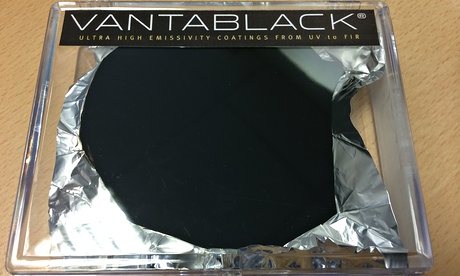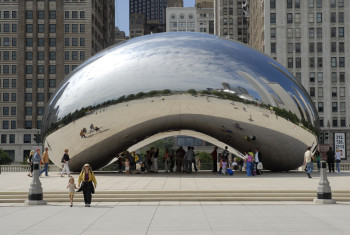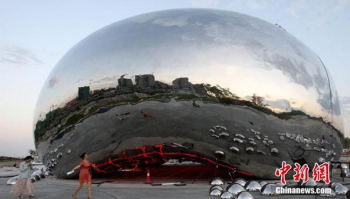Friday 11th March 2016Anish Kapoor and the Lure of Vantablack

Anish Kapoor, the well-known British artist who has designed a number of public artworks and architectural projects including the popular Cloud Gate sculpture in Chicago, has a brand new feather in his cap - although it's almost impossible to actually see.
Thanks to recent advances in nanotechnology, a firm based in the United Kingdom named Surrey NanoSystems has developed a material so dark that it absorbs 99.96% of all the light that hits it, known as Vantablack. As most artists know, objects take on colour by reflecting all the other wavelengths of light. A mirror reflects almost all the light that hits it, making it a near-perfect representation of the
“It's blacker than anything you can imagine. It's so black you almost can't see it. It has a kind of unreal quality. I've been working in this area for the last 30 years or so with all kinds of materials but conventional materials, and here's one that does something completely different," he explained. “I've always been drawn to rather exotic materials."
The deal naturally has some artists rather frustrated by the exclusive licensing deal between Surrey Nanosystems and Kapoor, suggesting that the quest for the darkest blacks has always been the province of dedicated artists throughout the course of history.
It's not the first time that artists have been granted exclusive access to use a particular colour, although there seems to be little available data how regularly someone would challenge such a patent agreement. Perhaps this is simply due to shoddy recordkeeping, or perhaps its due to the fact that it's hard to maintain your artistic credibility by using something so intimately associated with a single person. As far back as 1960, French artist Yves Klein created and patented a shade of blue known as International Klein Blue which he used to create a series of paintings, but to most people today it would be recognized as the same blue that adorns the faces of the art-theatre troupe The Blue Man Group.
Kapoor won't be the only person who has access to the nanomaterial, as several manufacturers have expressed intense interest in using the material, but the deal he has signed gives him exclusive license to develop the material into a spray-type "paint" and then use it in his projects, which means he is effectively the only artist in the world who will have access to it.
For now. With the technology needed to conduct nanotechnological research, it's probably only a matter of time before a competing firm comes up with a similar material, although it's still quite a coup for Kapoor.
Posted on March 11th 2016 on 04:47am
0 Comments
Wednesday 26th August 2015Did a Chinese City Steal the Bean?

One of the most intriguing and visually commanding pieces of public art in Chicago is a 2006 sculpture by Anish Kapoor entitled 'Cloud Gate'. It features a huge ovoid, typically referred to as 'the bean' by locals, which has been constructed out of mirror-quality chrome in order to reflect the clouds and sky above the Windy City. It's one of their most well-known pieces of public art, which makes it all the more galling to Kapoor that it appears a Chinese city has created a public art sculpture that is essentially exactly the same as his. (On the right, top: the original Cloud Gate, and below it, the Chinese knock-off).
The city of Karamay, in northern China, has begun to construct a virtually identical ripoff of Cloud Gate, and remarkably unapologetically. Speaking to the Wall Street Journal's China Real Time blog, Ma Jun, the head of the Karamay Tourism Bureau, said, “The idea of the oil bubble comes from the Black Oil Mountain, which is a natural oil well in Karamay. You can’t say we’re not allowed to build a round sculpture because there already is a round one.” Interestingly enough, Ma refused to name the artist who created their version of the bean, which as of yet appears to have no title.
Kapoor said in a statement, "It seems that in China today it is permissible to steal the creativity of others. I feel I must take this to the highest level and pursue those responsible in the courts. I hope that the Mayor of Chicago will join me in this action. The Chinese authorities must act to stop this kind of infringement and allow the full enforcement of copyright."
Curiously enough, the Mayor of Chicago, Rahm Emanuel, is a typically acerbic - even aggressive - public figure, and yet all he had to say on the subject was, "Imitation is the greatest form of flattery, is what I would say. And if you want to see original artwork like this or like the Bean, you come to Chicago." While that may seem rather blase on the surface, he sort of has a point - it's not too likely that many tourists are going to change their travel plans to China instead of Chicago just because of this plagiarism. But then on the other hand, any artist who has ever had their work misused can immediately attest to how incredibly infuriating it is to see someone else profiting off of your creativity and hard work.
Posted on August 26th 2015 on 03:20pm
0 Comments
 Anish Kapoor, the well-known British artist who has designed a number of public artworks and architectural projects including the popular Cloud Gate sculpture in Chicago, has a brand new feather in his cap - although it's almost impossible to actually see.
Anish Kapoor, the well-known British artist who has designed a number of public artworks and architectural projects including the popular Cloud Gate sculpture in Chicago, has a brand new feather in his cap - although it's almost impossible to actually see.
 One of the most intriguing and visually commanding pieces of public art in Chicago is a 2006 sculpture by Anish Kapoor entitled 'Cloud Gate'. It features a huge ovoid, typically referred to as 'the bean' by locals, which has been constructed out of mirror-quality chrome in order to reflect the clouds and sky above the Windy City. It's one of their most well-known pieces of public art, which makes it all the more galling to Kapoor that it appears a Chinese city has created a public art sculpture that is essentially exactly the same as his. (On the right, top: the original Cloud Gate, and below it, the Chinese knock-off).
One of the most intriguing and visually commanding pieces of public art in Chicago is a 2006 sculpture by Anish Kapoor entitled 'Cloud Gate'. It features a huge ovoid, typically referred to as 'the bean' by locals, which has been constructed out of mirror-quality chrome in order to reflect the clouds and sky above the Windy City. It's one of their most well-known pieces of public art, which makes it all the more galling to Kapoor that it appears a Chinese city has created a public art sculpture that is essentially exactly the same as his. (On the right, top: the original Cloud Gate, and below it, the Chinese knock-off).



